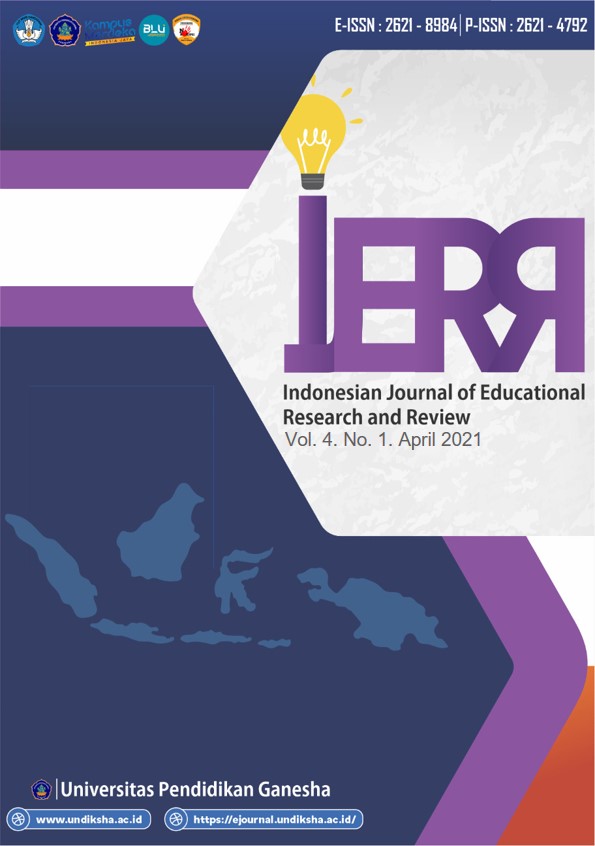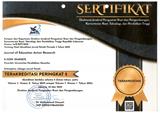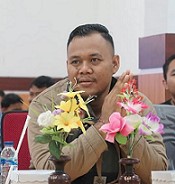Self-Directed Learning in EFL During Covid-19 Pandemic: Teacher’s Perception and Students’ Learning Autonomy
DOI:
https://doi.org/10.23887/ijerr.v4i1.33519Keywords:
Self-directed learning (SDL), teacher’s perception, online learning activitiesAbstract
Due to the global outbreak of coronavirus disease (COVID-19), new regulations require students to study from home so that students must be able to study independently. This study aimed to analyze teachers' perceptions of self-directed learning (SDL) and SDL components that can be identified from online learning activities assigned by teachers during the COVID-19 pandemic. This research was designed in the form of embedded mixed-method research. An English teacher at a high school was selected as a participant. Furthermore, data were collected through questionnaires, observations, and classification tables. The results showed that: 1) with a score of 4.00, teachers perceive themselves as "knowledgeable" about SDL knowledge, with a score of 3.57, teachers perceive themselves as "expected" or often carry out learning activities that support SDL, with a score of 3.88, teachers assessing the impact of SDL as “influential” on students, 2) components of SDL reflected through online learning activities assigned by the teacher are “developing a sense of belonging to students in learning” and “developing student self-monitoring” and self-management.” Thus, teachers perceive SDL positively, and there are two components of SDL promoted by teachers' online learning activities.
References
Agustuna, N. E., Herlina, R., & Faridah, D. (2019). Corrective Feedback on Pronunciation Errors: Teacher’s Perception and EFL High School Students’ Self-Reflection. Journal Of English Education And Teaching, 3(3). https://doi.org/https://doi.org/10.33369/jeet.3.3.311-327.
Alonderienė, R., & Suchotina, N. (2017). The Impact of Self-directed Learning on Work Performance of Lawyers. Organizations And Markets In Emerging Economies, 8(2). https://doi.org/https://doi.org/10.15388/omee.2017.8.2.14185.
Amiti, F. (2020). Synchronous and asynchronous E-learning. European Journal of Open Education and E-Learning Studies, 5(2), 60–70. https://doi.org/10.46827/ejoe.v5i2.3313.
Andrian, & Rusman. (2019). Implementasi Pembelajaran Abad 21 Dalam Kurikulum 2013. Jurnal Penelitian Ilmu Pendidikan, 12(1). https://doi.org/https://doi.org/10.21831/jpipfip.v12i1.20116. 14-23.
Ariebowo, T. (2021). Autonomous learning during COVID-19 pandemic : Students ’ objectives and preferences. Journal of Foreign Language Teaching and Learning, 6(1), 56–77. https://doi.org/https://doi.org/10.18196/ftl.v6i1.10079.
Atmojo, A. E. P., & Nugroho, A. (2020). EFL classes must go online! Teaching activities and challenges during COVID-19 pandemic in Indonesia. Register Journal, 13(1), 49–76. https://doi.org/https://doi.org/10.18326/rgt.v13i1.49-76.
Benson, P. (2016). Language learner autonomy: Exploring teachers’ perspectives on theory and practice. In Language learner autonomy : Teachers’ beliefs and practices in Asian contexts (pp. xxxiii–xliii). https://doi.org/http://dx.doi.org/10.5746/LEiA/LA_Asia.
Bharathi, P. (2014). Self – directed learning and learner autonomy in English language teacher education : Emerging trends. International Journal For Teachers of English, 4(1), 1–9.
Boyadzhieva, E. (2016). Learner-centered Teaching and Learner Autonomy. Procedia - Social and Behavioral Sciences, 232, 35–40. https://doi.org/10.1016/j.sbspro.2016.10.008.
Brandt, W. C. (2020). Measuring student success skills: A review of the literature on self-directed learning. Dover, NH: National Center for the Improvement of Educational Assessment.
Curry, N., Mynard, J., Noguchi, J., & Watkins, S. (2017). Evaluating a self-directed language learning course in a Japanese university. International Journal of Self-Directed Learning, 14(1), 17–36.
Daggol, G. D. (2017). Lifelong learning: Not a 21st century, but an omnitemporal skill. International Journal of Social Humanities Sciences Research (JSHSR), 4(12), 1254–1267. https://doi.org/10.26450/jshsr.207.
Darmadi, H. (2015). Tugas, Peran,Kompetensi, dan Tanggung Jawab Menjadi Guru Profesional. Jurnal Edukasi, 13(2). https://doi.org/http://dx.doi.org/10.31571/edukasi.v13i2.113.
Devi, S., Bhat, Ks., Ramya, S., Ravichandran, K., & Kanungo, R. (2016). Self-directed learning to enhance active learning among the 2nd -year undergraduate medical students in Microbiology: An experimental study. Journal of Current Research in Scientific Medicine, 2(2), 80–83. https://doi.org/10.4103/2455-3069.198379.
Durnali, M. (2020). The effect of self-directed learning on the relationship between self-leadership and online learning among university students in Turkey. Tuning Journal for Higher Education, 8(1), 129–165. https://doi.org/http://dx.doi.org/10.18543/tjhe-8(1)-2020pp129-165 Received.
Edriati, S., Anggraini, V., & Siska, M. (2015). Efektivitas Model Jigsaw Disertai Penilaian Diskusi Untuk Meningkatkan Kemampuan Matematis Mahasiswa. Cakrawala Pendidikan, 1(2). https://doi.org/https://doi.org/10.21831/cp.v2i2.4833.
Geng, S., Law, K. M. Y., & Niu, B. (2019). Investigating self-directed learning and technology readiness in blending learning environment. International Journal of Educational Technology in Higher Education, 16(1), 17. https://doi.org/10.1186/s41239-019-0147-0.
Gharti, L. (2019). Self-directed learning for learner autonomy: Teachers’ and students’ perceptions. Journal of NELTA Gandaki, 1, 62–73. https://doi.org/10.3126/jong.v1i0.24461.
Hanik, E. U. (2020). Self directed learning berbasis literasi digital pada masa pandemi covid-19 di Madrasah Ibtidaiyah. ELEMENTARY: Islamic Teacher Journal, 8(1), 183. https://doi.org/10.21043/elementary.v8i1.7417.
Hawkins, M. W. (2018). Self-directed learning as related to learning strategies, self-regulation, and autonomy in an English language program: A local application with global implications. Studies in Second Language Learning and Teaching, 8(2), 445–469. https://doi.org/10.14746/ssllt.2018.8.2.12.
Hill, M., Peters, M., Salvaggio, M., Vinnedge, J., & Darden, A. (2020). Implementation and evaluation of a self-directed learning activity for first-year medical students. Medical Education Online, 25(1), 1–10. https://doi.org/10.1080/10872981.2020.1717780.
Hirschman, K., & Wood, B. (2018). 21st century learners: Changing conceptions of knowledge, learning and the child. The New Zealand Annual Review of Education, 23(June), 20. https://doi.org/10.26686/nzaroe.v23i0.5280.
Humaira, S. A., & Hurriyah, I. A. (2018). Students ’ perspectives towards self-directed learning out of classroom. Advances in Social Science, Education and Humanities Research, 145, 7–11. https://doi.org/10.2991/iconelt-17.2018.2.
Khayati, N. A., Muna, F., Oktaviani, E. D., Hidayatullah, & Fauzan, A. (2020). Peranan Guru Dalam Pendidikan Inklusif Untuk Pencapaian Program Tujuan Pembangunan Berkelanjutan (SDG’s). Komunikasi Pendidikan, 4(1). https://doi.org/https://doi.org/10.32585/jkp.v4i1.440.
Khotimah, K., Widiati, U., Mustofa, M., & Faruq Ubaidillah, M. (2019). Autonomous English learning: Teachers’ and students’ perceptions. Indonesian Journal of Applied Linguistics, 9(2), 371–381. https://doi.org/10.17509/ijal.v9i2.20234.
Kristiantari, M. R. (2015). Analisis kesiapan guru sekolah dasar dalam mengimplementasikan pembelajaran tematik integratif menyongsong kurikulum 2013. JPI (Jurnal Pendidikan Indonesia), 3(2). https://doi.org/http://dx.doi.org/10.23887/jpi-undiksha.v3i2.4462.
Lailiyah, & Wulansari. (2017). Peningkatan Keterampilan Berbicara Melalui Metode Diskusi Kelompok Model Tanam Paksa Siswa Kelas X Pemasaran 1 SMK PGRI 2 Kediri. JP (Jurnal Pendidikan), 1(2), 166–173. https://doi.org/http://dx.doi.org/10.26740/jp.v1n2.p166-173.
Munaweroh, R. (2020). The use of English UKBM to support independent learning in senior high school. Research On English Language Teaching in Indonesia, 8(3), 1–10.
Shaalan, I. E.-N. A. W. (2019). Remodeling teachers’ and students’ roles in self-directed learning environments: The case of Saudi Context. Journal of Language Teaching and Research, 10(3), 549–556. https://doi.org/10.17507/jltr.1003.19.
Sugiyono. (2015). Metode penelitan kuantitatif, kualitatif dan R&D. Bandung: Alfabeta.
Suryadewi, N. K. A., Wiyasa, I. K. N., & Sujana, I. W. (2020). Kontribusi Sikap Mandiri dan Hubungan Sosial Terhadap Kompetensi Pengetahuan IPS. MIMBAR PGSD Undiksha, 8(1), 29–39. https://doi.org/http://dx.doi.org/10.23887/jjpgsd.v8i1.24576.
Tan, L., & Koh, J. H. (2014). Self-directed Learning : Learning in the 21st century. Singapore: Singapore Ministry of Education.
Timpau, C. (2015). Importance of self-directed learning. Logos Universality Mentality Education Novelty. Section: Social Sciences, 04(01), 37–49. https://doi.org/10.18662/lumenss.2015.0401.03.
Tjakradidjaja, F. A., Prabandari, Y. S., Prihatiningsih, T. S., & Harsono, H. (2016). The role of teacher in medical student self-directed learning process. Journal of Education and Learning (EduLearn), 10(1), 78–84. https://doi.org/10.11591/edulearn.v10i1.2992.
Van der Walt, H. (2016). The feasibility of grafting self-directed learning theory onto the capability theory. In E. Ments & I. Oosthuizen (Eds.), Self directed learning research (pp. 1–34). https://doi.org/http://dx.doi.org/10.4102/ aosis.2016.sdlr14.01.
Van Woezik, T., Reuzel, R., Koksma, J., & Serpa, S. (2019). Exploring open space: A self-directed learning approach for higher education. Cogent Education, 6(1), 1–22. https://doi.org/10.1080/2331186X.2019.1615766.
Vu, H. Y., & Shah, M. (2016). Vietnamese students’ self-direction in learning English listening skills. Asian Englishes, 18(1), 53–66. https://doi.org/10.1080/13488678.2015.1136104.
Wahyono, P., Husamah, H., & Budi, A. S. (2020). Guru profesional di masa pandemi COVID-19: Review implementasi, tantangan, dan solusi pembelajaran daring. Jurnal Pendidikan Profesi Guru, 1(1), 51–65. https://doi.org/https://doi.org/10.22219/jppg.v1i1.12462.
Wulandari, Sudatha, & Simamora. (2020). Pengembangan Pembelajaran Blended Pada Mata Kuliah Ahara Yoga Semester II di IHDN Denpasar. Jurnal Edutech Undiksha, 8(1), 1–15. https://doi.org/http://dx.doi.org/10.23887/jeu.v8i1.26459.
Yuli Asni. (2019). Pembinaan Kedisiplinan Dalam Proses Belajar Mengajar Terhadap Etos Kerja Mandiri Guru Sd Negeri 16 Bathin Solapan. Jurnal Pajar, 3(3). https://doi.org/https://doi.org/10.33578/pjr.v3i3.7252.
Yuzulia, I. (2020). EFL tecahers’ perceptions and stratgeies in inplementing learner autonomy. Journal of Linguistics and Language Teaching, 6(1), 36–54. https://doi.org/http://dx.doi.org/10.29300/ling.v6i1.2744.
Zhu, M., Bonk, C. J., & Doo, M. Y. (2020). Self-directed learning in MOOCs: Exploring the relationships among motivation, self-monitoring, and self-management. Educational Technology Research and Development, 68(5), 2073–2093. https://doi.org/10.1007/s11423-020-09747-8.
Downloads
Published
Issue
Section
License
Authors who publish with the Indonesian Journal of Educational Research and Review (IJERR) agree to the following terms:
- Authors retain copyright and grant the journal the right of first publication with the work simultaneously licensed under a Creative Commons Attribution License (CC BY-SA 4.0) that allows others to share the work with an acknowledgment of the work's authorship and initial publication in this journal.
- Authors are able to enter into separate, additional contractual arrangements for the non-exclusive distribution of the journal's published version of the work (e.g., post it to an institutional repository or publish it in a book), with an acknowledgment of its initial publication in this journal.
- Authors are permitted and encouraged to post their work online (e.g., in institutional repositories or on their website) prior to and during the submission process, as it can lead to productive exchanges, as well as earlier and greater citation of published work. (See The Effect of Open Access)












